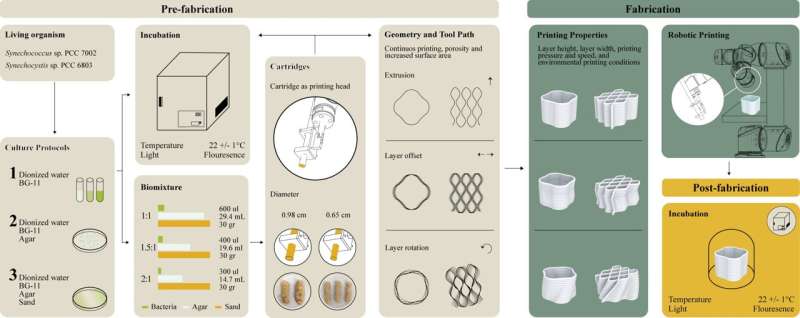This article has been reviewed according to Science X's editorial process and policies. Editors have highlighted the following attributes while ensuring the content's credibility:
fact-checked
trusted source
proofread
Building bacteria: Researchers use cyanobacteria to 'grow' stronger sand-based construction materials

Researchers have successfully grown bacterial cells in potential sand-based construction materials, as detailed in a paper published by Research Directions: Biotechnology Design.
This achievement marks a substantial contribution to the field of biodesign, which seeks to incorporate living organisms into building materials as a means of making architecture more sustainable. It is effectively a fusion of biological and architectural expertise, with the shared goal of building better.
Cyanobacteria could enable the solidification of inorganic materials such as CO2, as they hold a range of biological activities that impact their environment. This suggests that the integration of living organisms into design processes could prove highly valuable within industries such as construction.
The paper capturing this latest research into potential sand-based materials describes the novel development of an additive co-fabrication manufacturing process.
Specifically, the process explored involves the biological deposition of bacteria—such as cyanobacterial calcium carbonate precipitation—and its integration with a robotic deposition, namely a sand-based biomixture, within an architectural biofabrication workflow.
After successfully growing two bacterial strains in potential sand-based construction materials, the researchers used microbiological protocols, such as optical density and fluorescence measurements, to follow bacterial growth and activity. This was done with the larger goal of harvesting light through photosynthesis and harnessing it to CO2 deposition and the sedimentation of calcium carbonate for strengthening sand-based construction components.
Ultimately, the researchers managed to outline a robotic deposition system for sand-based mixtures.
The paper was co-authored by researchers at the Technion Israel Institute of Technology, in Haifa, Israel, in the Faculty of Architecture and Town Planning and the Faculty of Biotechnology and Food Engineering.
Asst. Prof. Shany Barath, director of Disrupt.Design Lab, and Ph.D. candidate Perla Armaly, of the Faculty of Architecture and Town Planning, further detailed the value and impact of the research.
"The experiments presented in our study offer a novel design approach to producing bio-based architectural components potentially capable of fixating carbon dioxide throughout an additive co-fabrication workflow," they explained.
"Society needs paths towards more sustainable construction materials—and we hope to develop one of these paths."
"Our hope is that our study's findings will encourage further collaboration between architects and biologists, creating and enhancing building materials, and in turn fostering more sustainable construction. By working together across disciplines, we can find innovative, unexpected solutions—and that's something to get excited about."
More information: Perla Armaly et al, Prototyping an additive co-fabrication workflow for architecture: utilizing cyanobacterial MICP in robotic deposition, Research Directions: Biotechnology Design (2023). DOI: 10.1017/btd.2023.5















